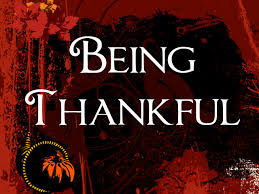
As fall weather turns colder and colder, and family celebrations lurk just around the corner, November seems the perfect time to consider all the things for which we’re grateful. Favorite foods, good friends who know just what to say during periods of doubt, time spent with loved ones, moments of peace at home and abroad, and daily blessings can all be counted as things worth celebrating. For many of us, being able to read books that make us smile or cry also provides a reason to stop and give thanks. This week members of the Children’s Literature and Reading Special Interest Group describe books that make us say, “I’m thankful for…”
Teachers might like to use these lesson ideas from ReadWriteThink: “Packing the Pilgrim’s Trunk: Personalizing History in the Elementary Classroom,” “Myth and Truth: The First Thanksgiving,” or “Spend a Day in My Shoes: Exploring the Role of Perspective in Narrative.”
GRADES K-3
Besel, Jennifer M. (2013). A Thanksgiving drawing feast! Illus. by Lucy Makuc. Mankato, MN: Capstone Press.
 “Filling Up on Art” opens this drawing book with beginner’s tips for creating with pencil drawings for the Thanksgiving and autumn holidays. Suggested supplies, including drawing paper, pencils, erasers, colored pencils, markers, and a pencil sharpener prepare young readers and artists for their first steps in drawing. The book provides step-by-step instructions for pumpkins, Pilgrim hats, pumpkin pie, the Mayflower, a cornucopia, and of course, a turkey.
“Filling Up on Art” opens this drawing book with beginner’s tips for creating with pencil drawings for the Thanksgiving and autumn holidays. Suggested supplies, including drawing paper, pencils, erasers, colored pencils, markers, and a pencil sharpener prepare young readers and artists for their first steps in drawing. The book provides step-by-step instructions for pumpkins, Pilgrim hats, pumpkin pie, the Mayflower, a cornucopia, and of course, a turkey.
— Karen Hildebrand, Ohio Library and Reading Consultant
Coble, Colleen. (2013). The blessings jar: A story about being thankful. Illus. by Rebecca Henry. Nashville, TN: Thomas Nelson Publisher.
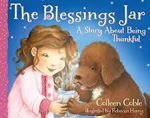 Punky Grace is upset that her friend can’t play with her because she is sick. She is a bit grumpy about the situation, and so her grandmother tells her that a cure for the grumpies is to “go on an adventure today and try to fill the jar with things that remind us of God’s blessings.” Punky Grace and her grandmother begin to look for things that make them happy and thankful—like walks on the beach, cookie cutters, playtime with the dog, a bookmark, and more. As the day moves along, Punky discovers that her grumpies are gone, and she has a new outlook on things that fill her with gratitude, take away sadness, and bring joy to life.
Punky Grace is upset that her friend can’t play with her because she is sick. She is a bit grumpy about the situation, and so her grandmother tells her that a cure for the grumpies is to “go on an adventure today and try to fill the jar with things that remind us of God’s blessings.” Punky Grace and her grandmother begin to look for things that make them happy and thankful—like walks on the beach, cookie cutters, playtime with the dog, a bookmark, and more. As the day moves along, Punky discovers that her grumpies are gone, and she has a new outlook on things that fill her with gratitude, take away sadness, and bring joy to life.
— Karen Hildebrand, Ohio Library and Reading Consultant
Halperin, Wendy Anderson. (2013). Peace. New York, NY: Atheneum/Simon and Schuster.
 Even though this book is pitched to a young age group, it is a beautiful book for all ages. Illustrated with rich watercolor paintings that appear like unusual windows or panels that meander through the book, Halperin uses quotations from noted world leaders supporting concepts of peace. This might be a difficult book to read aloud, but coupled with the delicate drawings children will pore over the details and flowing words on each page, probably to revisit with renewed interest at each reading. Starting with the statement, “For there to be peace in the world, there must be peace in the nations” (unpaged). Beginning with this global outlook and then bringing the text and quotations into a more local perspective, from nations to homes to oneself, the author offers insight into bringing peace into the world through the eyes of children. Teachers might like to use this 5-minute video created by the author featuring her Peace Chairs based on the “Sit in Peace” concept from the Drawing Children into Peace project.
Even though this book is pitched to a young age group, it is a beautiful book for all ages. Illustrated with rich watercolor paintings that appear like unusual windows or panels that meander through the book, Halperin uses quotations from noted world leaders supporting concepts of peace. This might be a difficult book to read aloud, but coupled with the delicate drawings children will pore over the details and flowing words on each page, probably to revisit with renewed interest at each reading. Starting with the statement, “For there to be peace in the world, there must be peace in the nations” (unpaged). Beginning with this global outlook and then bringing the text and quotations into a more local perspective, from nations to homes to oneself, the author offers insight into bringing peace into the world through the eyes of children. Teachers might like to use this 5-minute video created by the author featuring her Peace Chairs based on the “Sit in Peace” concept from the Drawing Children into Peace project.
— Karen Hildebrand, Ohio Library and Reading Consultant
Judge, Lita. (2013). Red hat. New York, NY: Simon & Schuster/Atheneum Books for Young Readers.
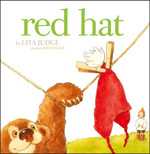 Even the warmest, most favorite of red knit hats eventually must be washed and hung out to dry. The hat’s owner wouldn’t be blamed for being annoyed at what happens while the hat is hanging on the line. The brightly-colored hat with its bobbing cottontail attracts the attention of several playful animals watching nearby. First, a bear snatches the hat from its perch, and then other frisky critters get in on the action, snatching and tossing the hat until its yarn has completely unraveled. When the little girl whose hat the woodland creatures have demolished sees it, she doesn't become upset. Instead, she sits right down in the yard and knits enough hats for everyone. Maybe she knows just how tempting a red hat can be and how thankful those animals will be to have a little warmth for their own heads. The pencil and watercolor illustrations in this appealing picture book complement the almost-wordless text, filled primarily with chortles of glee uttered by the animals and sounds that accompany their surreptitious borrowing of the red hat.
Even the warmest, most favorite of red knit hats eventually must be washed and hung out to dry. The hat’s owner wouldn’t be blamed for being annoyed at what happens while the hat is hanging on the line. The brightly-colored hat with its bobbing cottontail attracts the attention of several playful animals watching nearby. First, a bear snatches the hat from its perch, and then other frisky critters get in on the action, snatching and tossing the hat until its yarn has completely unraveled. When the little girl whose hat the woodland creatures have demolished sees it, she doesn't become upset. Instead, she sits right down in the yard and knits enough hats for everyone. Maybe she knows just how tempting a red hat can be and how thankful those animals will be to have a little warmth for their own heads. The pencil and watercolor illustrations in this appealing picture book complement the almost-wordless text, filled primarily with chortles of glee uttered by the animals and sounds that accompany their surreptitious borrowing of the red hat.
— Barbara A. Ward, Washington State University Pullman
Pendziwol, Jean E. (2013). Once upon a northern night. Illus. by Isabelle Arsenault. Toronto, CA: House of Anansi/ Groundwood Books.
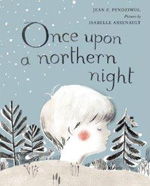 This lyrical and quiet poetic verse sets the tone for a beautiful and silent look at the evening sky and the whisper of snow. “Once upon a northern night/ while you were sleeping, /wrapped in a downy blanket, /I painted you a picture” opens the book and the wondrous scene of a cold winter night lullaby beckons. Black and white images reflect the night, yet dabs of color are present when an owl or a red-tailed fox appear. Winter images of animals passing through add to the nocturnal hush when a mother deer and fawn, a small mouse, and horseshoe hares come into view. An appreciation of the cold winter night sky in this book brings a shiver along with delight. Teachers might like to show the 2-minute book trailer as an anticipatory writing prompt about winter. This book has been nominated for the Governor General’s Award sponsored by the Canada Council for the Arts.
This lyrical and quiet poetic verse sets the tone for a beautiful and silent look at the evening sky and the whisper of snow. “Once upon a northern night/ while you were sleeping, /wrapped in a downy blanket, /I painted you a picture” opens the book and the wondrous scene of a cold winter night lullaby beckons. Black and white images reflect the night, yet dabs of color are present when an owl or a red-tailed fox appear. Winter images of animals passing through add to the nocturnal hush when a mother deer and fawn, a small mouse, and horseshoe hares come into view. An appreciation of the cold winter night sky in this book brings a shiver along with delight. Teachers might like to show the 2-minute book trailer as an anticipatory writing prompt about winter. This book has been nominated for the Governor General’s Award sponsored by the Canada Council for the Arts.
— Karen Hildebrand, Ohio Library and Reading Consultant
Rottner, Shelley and Sheila Kelly. (2014). Feeling thankful. Mankato, MN: Capstone Press.
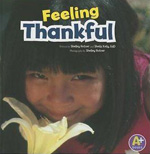 With large, colorful photography, ideas that fill the lives of children and things they are thankful for are presented. Using large and simple text, the book opens with, “I am thankful for ME …” and continues with photographs that represent activities that children do like riding a bike, playing soccer, finger painting, or being thankful for the people in their lives like family, friends and teachers. Being thankful for birds and butterflies and playgrounds and walking in the rain offer just a few more of the many things in the lives of children that can be observed with a smile and a word of thanks.
With large, colorful photography, ideas that fill the lives of children and things they are thankful for are presented. Using large and simple text, the book opens with, “I am thankful for ME …” and continues with photographs that represent activities that children do like riding a bike, playing soccer, finger painting, or being thankful for the people in their lives like family, friends and teachers. Being thankful for birds and butterflies and playgrounds and walking in the rain offer just a few more of the many things in the lives of children that can be observed with a smile and a word of thanks.
— Karen Hildebrand, Ohio Library and Reading Consultant
Sayre, April Pulley. (2013). Let’s go, nuts! Seeds we eat. Illus. by Steve Jenkins. New York, NY: Simon & Schuster/Beach Lane Books.
 Although many of us love our fruits and veggies, this book provides a vivid reminder of the joys of seeds. Readers are likely to be unaware that nuts, beans, grains, and some spices are all edible seeds. Through a series of visually appealing photographic close-ups of a wide variety of beans, chickpeas, and yummy nuts, the author encourages the consumption and celebration of these delicious foods. Because there are so many seeds photographed and labeled, readers may be curious and eager to try some of the less familiar ones. Back matter includes additional information on seeds, including why they can't grow inside our stomachs and what makes them such good energy sources. Visually appealing and informative, and written in an engaging, pun-filled fashion, this book prompts cheers of delight even while readers are munching on a handful of nuts or savoring a mouthful of beans. Most of us are thankful to have life-sustaining seeds on which to chew.
Although many of us love our fruits and veggies, this book provides a vivid reminder of the joys of seeds. Readers are likely to be unaware that nuts, beans, grains, and some spices are all edible seeds. Through a series of visually appealing photographic close-ups of a wide variety of beans, chickpeas, and yummy nuts, the author encourages the consumption and celebration of these delicious foods. Because there are so many seeds photographed and labeled, readers may be curious and eager to try some of the less familiar ones. Back matter includes additional information on seeds, including why they can't grow inside our stomachs and what makes them such good energy sources. Visually appealing and informative, and written in an engaging, pun-filled fashion, this book prompts cheers of delight even while readers are munching on a handful of nuts or savoring a mouthful of beans. Most of us are thankful to have life-sustaining seeds on which to chew.
— Barbara A. Ward, Washington State University Pullman
GRADES 3-5
Henkes, Kevin. (2013). The year of Billy Miller. New York, NY: HarperCollins/Greenwillow Books.
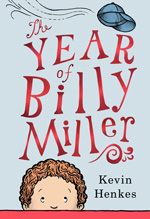 After surviving a fall during summer vacation, second grader Billy Miller worries about his intelligence. His anxiety is heightened by the constant disparaging of Emma, a new classmate, and he even starts off on the wrong foot with his teacher, Ms. Silver. As Billy tries to figure out his place in his class this year, his supportive parents make sure he feels loved. The book is divided into four sections: "Teacher," "Father," "Sister," and "Mother," allowing the author to explore Billy's relationships with each of those important individuals.
After surviving a fall during summer vacation, second grader Billy Miller worries about his intelligence. His anxiety is heightened by the constant disparaging of Emma, a new classmate, and he even starts off on the wrong foot with his teacher, Ms. Silver. As Billy tries to figure out his place in his class this year, his supportive parents make sure he feels loved. The book is divided into four sections: "Teacher," "Father," "Sister," and "Mother," allowing the author to explore Billy's relationships with each of those important individuals.
Despite his rocky start, Billy builds strong relationships with each of the four and even writes and recites a poem in honor of his mother. Teacher readers will smile at Ms. Silver's classroom lessons and her affection for poetry. Parents will enjoy the passages dealing with little sister Sal and her stuffed animals collectively named the Drop Sisters as well as the two siblings' heroic efforts to stay up all night when they have the chance to do so. Billy Miller’s year turns out to be a satisfying one, after all, making this title a wonderfully reassuring read aloud for sharing right before the start of a new experience. As always with this author/illustrator, the scenes in which characters struggle with fears—in this case, with public speaking—are honest and end with a quiet triumph of their own.
— Barbara A. Ward, Washington State University Pullman
MacLachlan, Patricia. (2013). White fur flying. New York, NY: Simon & Schuster/Margaret K. McElderry Books.
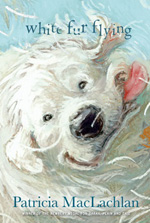 Anyone who shares a home with a cat or dog knows that their furry companions shed plenty of hair, which makes it hard to keep an animal-filled house fur-free. The Cassidy family is filled with dog lovers. The father works as a veterinarian, and the mother provides a foster home for Great Pyrenees until they can find their forever homes. When the Crofts move in next door, it's clear that the animal-loving lifestyle of the Cassidy family is foreign to them. But Phillip, the quietly sad boy who is staying with them while his parents work out their differences, is drawn to Kodi, one of the Cassidy dogs, and Kodi is drawn to him. Although he doesn't speak to humans, he does speak to Kodi.
Anyone who shares a home with a cat or dog knows that their furry companions shed plenty of hair, which makes it hard to keep an animal-filled house fur-free. The Cassidy family is filled with dog lovers. The father works as a veterinarian, and the mother provides a foster home for Great Pyrenees until they can find their forever homes. When the Crofts move in next door, it's clear that the animal-loving lifestyle of the Cassidy family is foreign to them. But Phillip, the quietly sad boy who is staying with them while his parents work out their differences, is drawn to Kodi, one of the Cassidy dogs, and Kodi is drawn to him. Although he doesn't speak to humans, he does speak to Kodi.
The story is told from the point of view of Zoe, the older Cassidy sister. She and her sister Alice, a writer, befriend Phillip too, and watch as he warms up to them. But it takes an almost-tragedy involving another rescue dog to get Phillip to find his voice. By the time he does, it is clear just how much he means to Phyllis Croft, and how little it matters that dogs bring fur and disorder to our lives, but oh, how much love, companionship, and meaning they also bring. Readers of this quietly powerful book will be touched by this family’s abundant affection, with enough love to find a place for a poetry-spouting African grey parrot named Lena. The author’s soft spot for living things shows in every line. This book is a perfect read aloud choice, offering plenty of food for thought about what it takes to save a life, whether it is the life of a parrot, dog, or human.
— Barbara A. Ward, Washington State University Pullman
Olmos, Gabriela. (2013). I dreamt …: a book about hope. Translated by Elisa Amado. Toronto, CA: Groundwood Books.
 Twelve Mexican artists donated their work to illustrate this very unusual picture book about violence and hope through the auspices of the IBBY. All proceeds from the book are going to the Children in Crisis Fund. This book will leave readers of all ages uncomfortable and pondering the concepts of children and war, guns, violence, fear and hope. These beautiful illustrations accompany vignettes provided by the author to represent the thoughts and dreams of children as they hope for peace in their futures. “I dreamt of pistols that shoot butterflies…and of drug lords who only sell soap bubbles,” or “I dreamt that wars are always fought with flowers…and that soldiers prefer shadowboxing to shooting at each other.” Author Gabriela Olmos encourages children to be strong and resilient at they observe and learn to find ways to abort the violence around them. A powerful and unsettling book, teachers may want to pair it with Halperin’s Peace, a book reviewed earlier to juxtapose concepts of peace.
Twelve Mexican artists donated their work to illustrate this very unusual picture book about violence and hope through the auspices of the IBBY. All proceeds from the book are going to the Children in Crisis Fund. This book will leave readers of all ages uncomfortable and pondering the concepts of children and war, guns, violence, fear and hope. These beautiful illustrations accompany vignettes provided by the author to represent the thoughts and dreams of children as they hope for peace in their futures. “I dreamt of pistols that shoot butterflies…and of drug lords who only sell soap bubbles,” or “I dreamt that wars are always fought with flowers…and that soldiers prefer shadowboxing to shooting at each other.” Author Gabriela Olmos encourages children to be strong and resilient at they observe and learn to find ways to abort the violence around them. A powerful and unsettling book, teachers may want to pair it with Halperin’s Peace, a book reviewed earlier to juxtapose concepts of peace.
— Karen Hildebrand, Ohio Library and Reading Consultant
GRADES 6-8
Brown, Don. (2013). The Great American Dust Bowl. New York, NY: Houghton Mifflin Harcourt Books for Young Readers.
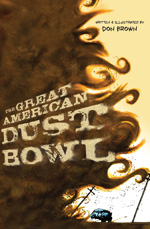 This highly recommended nonfiction account of the 1930s Dust Bowl provides reasons for the disaster while focusing primarily on Black Sunday, April 14, 1935, when dust-filled clouds covered much of the Great Plains, and topsoil was moved from one place to the next. The lively text draws readers into a time in history during which American citizens solved one environmental disaster by creating another one. The author describes how jack rabbits were herded together and killed and how some superstitious homesteaders nailed dead snakes to fences to bring rain, both misguided practices sure to wreak havoc on nature. The pen and ink and digital paint illustrations portray this historical period so vividly that readers will feel as though they need to bathe or shower after reading the book and viewing this graphic novel’s images. Citing a recent lengthy drought in the same area and extremely high summer temperatures, the final pages provide a warning that something similar may occur again. This title will be a perfect pairing with Matt Phelan's earlier The Storm in the Barn (Candlewick, 2009), which covers some of the same territory albeit through a fictional lens.
This highly recommended nonfiction account of the 1930s Dust Bowl provides reasons for the disaster while focusing primarily on Black Sunday, April 14, 1935, when dust-filled clouds covered much of the Great Plains, and topsoil was moved from one place to the next. The lively text draws readers into a time in history during which American citizens solved one environmental disaster by creating another one. The author describes how jack rabbits were herded together and killed and how some superstitious homesteaders nailed dead snakes to fences to bring rain, both misguided practices sure to wreak havoc on nature. The pen and ink and digital paint illustrations portray this historical period so vividly that readers will feel as though they need to bathe or shower after reading the book and viewing this graphic novel’s images. Citing a recent lengthy drought in the same area and extremely high summer temperatures, the final pages provide a warning that something similar may occur again. This title will be a perfect pairing with Matt Phelan's earlier The Storm in the Barn (Candlewick, 2009), which covers some of the same territory albeit through a fictional lens.
— Barbara A. Ward, Washington State University Pullman
McMurchy-Barber, Gina. (2013). When children play: the story of Right to Play. Montreal, Quebec: Fitzhenry & Whiteside.
 The author has explained the background of the origin and development of the organization, Right to Play (RTP) that began in refugee camps in Angola and Cote d’ Avoire in 2001. ESPN television created a documentary film that explains the founder Johann Olav Koss, four-time Olympic Norwegian gold medalist and social entrepreneur, and his vision for using sports and games to help children all over the world build better futures. Children have “play” in common no matter the language. They don’t need elaborate arenas or gymnasiums. However, the Right to Play organization is trying to supply kids with balls and other equipment with their standard being a bright red soccer ball printed with the RTP logo. Recruiting volunteers, coaches, teachers and professional athletes has lead to the success of this international endeavor. The author has provided a glimpse at the many true stories of children around that globe that have been impacted by the RTP program.
The author has explained the background of the origin and development of the organization, Right to Play (RTP) that began in refugee camps in Angola and Cote d’ Avoire in 2001. ESPN television created a documentary film that explains the founder Johann Olav Koss, four-time Olympic Norwegian gold medalist and social entrepreneur, and his vision for using sports and games to help children all over the world build better futures. Children have “play” in common no matter the language. They don’t need elaborate arenas or gymnasiums. However, the Right to Play organization is trying to supply kids with balls and other equipment with their standard being a bright red soccer ball printed with the RTP logo. Recruiting volunteers, coaches, teachers and professional athletes has lead to the success of this international endeavor. The author has provided a glimpse at the many true stories of children around that globe that have been impacted by the RTP program.
“When children play, the world wins!” is the motto and goal of this social action movement. Teachers might like to use the website resources at Right to Play that includes videos and background information about the lives of children around the world and their right to play and be children. Learn more about the author and how this book originated at the author’s website.
— Karen Hildebrand, Ohio Library and Reading Consultant
Sloan, Holly Goldberg. (2013). Counting by 7s. New York, NY: Penguin/Dial.
 After twelve-year-old Willow Chance loses her adopted parents in a car wreck, her world crumbles. Her parents nurtured her unique interests and hobbies, such as her fascination with human medical conditions and gardening on a large scale. Accused of cheating on a standardized test, Willow is sent to counseling with the decidedly incompetent Dell Duke, who becomes fascinated with her genius status. She meets Nguyen Thi Mai and Nguyen Quang-ha at the counseling office and is quickly impressed with Mai’s ability to get things done. After Willow’s world is upended, Mai steps in to offer help, and Willow slowly takes an interest in the world around her again.
After twelve-year-old Willow Chance loses her adopted parents in a car wreck, her world crumbles. Her parents nurtured her unique interests and hobbies, such as her fascination with human medical conditions and gardening on a large scale. Accused of cheating on a standardized test, Willow is sent to counseling with the decidedly incompetent Dell Duke, who becomes fascinated with her genius status. She meets Nguyen Thi Mai and Nguyen Quang-ha at the counseling office and is quickly impressed with Mai’s ability to get things done. After Willow’s world is upended, Mai steps in to offer help, and Willow slowly takes an interest in the world around her again.
Willow's innate goodness will prompt readers to root for her. Somehow, she makes those around her better just by knowing her. There are so many philosophical moments contained in this book as well as reminders about how everything seems to connect and how our actions always have consequences. Like the sunflower seeds Willow plants, this book plants seeds of hope that each of us can make this world a better place, starting with ourselves. Surely, this book is a vivid reminder of the need humans have for family and connections, something for which to be thankful.
— Barbara A. Ward, Washington State University Pullman
Timberlake, Amy. (2013). One came home. New York, NY: Random House/Knopf Books for Young Readers.
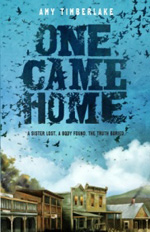 Thirteen-year-old Georgie Burkhardt adores her older sister Agatha. When Agatha leaves home, her remains are discovered and buried only a few days later. Georgie feels compelled to make sure that Agatha is dead. And if she isn't, then Georgie needs to make sense of what has happened. After all, she blames herself for revealing her sister's dalliance with another man to her fiancé. She sets off on a detective mission for Dog Hollow where some of her sister's remains and her ball gown were found.
Thirteen-year-old Georgie Burkhardt adores her older sister Agatha. When Agatha leaves home, her remains are discovered and buried only a few days later. Georgie feels compelled to make sure that Agatha is dead. And if she isn't, then Georgie needs to make sense of what has happened. After all, she blames herself for revealing her sister's dalliance with another man to her fiancé. She sets off on a detective mission for Dog Hollow where some of her sister's remains and her ball gown were found.
Middle graders will surely be captivated by the outspoken, sharpshooting Georgie as she befriends a mule she calls Long Ears and comes to terms with her own fears, talents, and regard for life. The author sets her book in 1871 rural Wisconsin and fills it with wonderfully descriptive passages detailing the passenger pigeons that filled the skies in the area and the destruction that followed in their wake. This page-turner will keep readers riveted as they race through its content while occasionally stopping to think about how quickly those birds would disappear from the skies. Readers will relish reading about the inspiration for the book and the fetching way in which it evokes a sense of time and place.
— Barbara A. Ward, Washington State University Pullman
GRADES 9-12
Hobbs, Will. (2013). Never say die. New York, NY: HarperCollins.
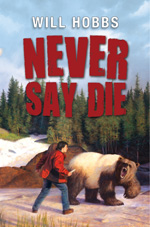 Fifteen-year-old Inuit Nick Thrasher heads into the wilderness with the older brother he has never met. His brother, Ryan Powers, is a photographer intent on capturing shots of the caribou herds as they migrate in the Arctic. The trip starts off with a river accident that threatens both of their lives, and they must forage for food, find shelter, and avoid the hungry bears that are in the area. To add insult to injury, their boat, radio, and supplies have been lost, and when they finally locate them, they must beware of a renegade grolar, a hybrid animal that is part-polar bear, part-grizzly, that is foraging in the area.
Fifteen-year-old Inuit Nick Thrasher heads into the wilderness with the older brother he has never met. His brother, Ryan Powers, is a photographer intent on capturing shots of the caribou herds as they migrate in the Arctic. The trip starts off with a river accident that threatens both of their lives, and they must forage for food, find shelter, and avoid the hungry bears that are in the area. To add insult to injury, their boat, radio, and supplies have been lost, and when they finally locate them, they must beware of a renegade grolar, a hybrid animal that is part-polar bear, part-grizzly, that is foraging in the area.
The descriptions of how the two manage to survive their sojourn in the wilderness, set against the backdrop of environmental changes wrought by climate change and global warming, are particularly powerful as are the scenes in which the caribou surround them. Because the author has taken pains to present different perspectives to the issue of diminishing natural resources as well as the Inuits’ need for food and jobs, the book raises important environmental questions for readers to ponder.
— Barbara A. Ward, Washington State University Pullman
These reviews are submitted by members of the International Reading Association's Children's Literature and Reading Special Interest Group (CL/R SIG) and are published weekly on Reading Today Online. The International Reading Association partners with the National Council of Teachers of English and Verizon Thinkfinity to produce ReadWriteThink.org, a website devoted to providing literacy instruction and interactive resources for grades K–12.